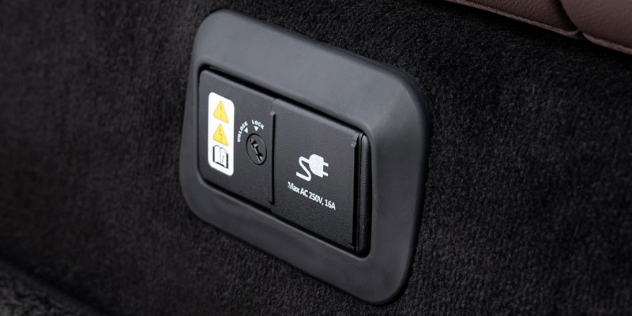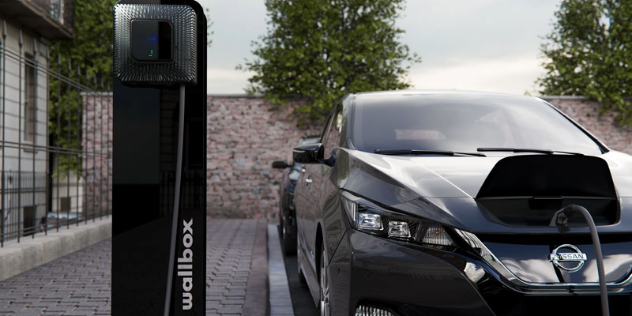V2G, V2H and V2L: How electric cars can power the grid, buildings and devices

V2L, V2H and V2G are terms for specific types of two-way EV charging. We explain what it all means for EV owners, for homes and businesses, and for the electricity grid.
What is V2L and how does it work?
V2L is one of the three pillars of V2X (vehicle-to-everything.) It stands for vehicle-to-load and is the simplest way to use energy from lithium-ion batteries in electric vehicles (EVs) to power something else.
This ability is also known as bidirectional charging, or two-way charging. In an EV with V2L, there are two methods of charging other devices.
One way is via a special adapter with a standard 240-volt power point that can be inserted into the charging port, as in the picture above. This is known as external V2L output. Some EVs also have internal V2L, which is simply an internal power point.

Can V2L be used to power my house during a blackout?
Technically yes, as one NRMA member has done. To do this, an electrician installs a generator inlet with a manual 'changeover switch' (also known as a 'break-then-make' switch) that isolates a chosen circuit in the home.
During a blackout an EV with V2L can be plugged into the generator inlet, with an adapter, to power the circuit.
Note, the power supplied to your home is limited by the AC inverter in the EV and may not be able to surge above the power limit of the V2L system. Fridges and freezers need extra power when they cycle on, so this needs to be accounted for when running certain appliances.
Even if a home doesn’t have a generator inlet, V2L can be used to power critical appliances. One Gold Coast family did this in a recent storm-induced blackout. The Holmes used the V2L function of their BYD Atto 3 to power fridges and their son’s dialysis machine. Thanks to this, the family did not need to travel to a hospital for life-saving treatment.
What are V2H and V2G?
V2H stands for vehicle-to-home and V2G stands for vehicle-to-grid. They are two sides of the same coin, because the technology is the same and the only difference is how it is used.
Why use vehicle-to-home?
V2H can power the whole home electricity circuit using the energy stored in an EV's lithium-ion battery. Because an EV battery is often 4-5 times bigger than a typical 12-14kWh home storage battery, it has much more energy available. There are many advantages to this, such as being able to charge the car up using renewable energy during the day, and then using that energy to power appliances at night. Also, it means the EV could in theory power a home for a week in an extended blackout event.Why use vehicle-to-grid?
V2G enables an EV to put energy from its battery back into the electricity grid.
Like V2H, V2G can help us make the best use of renewable energy. Energy providers could pay drivers to support the grid by charging the EV or discharging energy at a certain time.
For example, an EV driver might be paid to “soak up” extra energy during the day when there is lots of solar energy in the grid. Or, they might store their own free solar energy while parked at home.
Then, when demand for energy is high in the evening and there is little or no solar energy, energy providers could pay EV drivers to discharge energy to the grid, reducing fossil fuel use.
These methods can help to smooth out the peaks and troughs of energy demand, making the electricity grid more stable.
How do V2H and V2G work?
V2H and V2G are a step up from V2L, because they require extra equipment to allow the EV to connect to the home.
To work, it currently needs a bidirectional EV charger connected to the switchboard that uses vehicle communications protocol ISO 15118 and OCPP 2.0.1 (Open Charge Point Protocol) installed by a licensed electrician.
A smart meter with smart “virtual power plant” technology (VPP) is also used to manage the process.
In V2G, the smart meter uses ISO 15118 to let the grid know how much energy the EV has stored in its battery.
The energy management software can then decide how much energy can be discharged to the local grid to help fill in the grid troughs.

Can I use V2H or V2G in Australia?
As of now, South Australia is the only state that allows bidirectional chargers to be installed in homes.
But, currently only EVs using CHAdeMO plugs can discharge energy this way. This includes the Nissan Leaf and Mitsubishi PHEVs.
Bidirectional chargers are expensive, costing $10,000, and the payback time for households is still more than ten years according to according to the results of the “Realising Electric Vehicle-to-Grid Services”1 trial.
However, soon EVs with CCS2 plugs will also be capable of V2H/V2G, and installing a bidirectional charger will be as simple as installing a solar inverter.
Changes to the AS4777.2 standard which governs inverters will mean more companies can introduce bidirectional chargers that can be used with CCS2 plugs, and which don’t have to use smart VPPs.
Over time, bidirectional chargers will also become cheaper (about 10-20% more than a solar inverter.)
Wallbox, the company that makes the charger used in the SA Power Networks trial, says it will release a next-gen bidirectional charger in 2024 according to Jetcharge.
Which cars have two-way charging capabilities?
Several EVs currently available in Australia have V2L capabilities. Brands that make EVs with V2L include Nissan, MG, BYD, Kia, Hyundai and Genesis, Hyundai’s luxury brand. Mitsubishi plug-in hybrids (PHEVs) like the Outlander and Eclipse Cross also have V2L functionality. Volkswagen is also launching its ID range soon, with V2L included.
|
Model |
V2L Output |
V2L Voltage |
Internal V2L Points |
External V2L Points |
|
Hyundai Ioniq 5 |
3.6 kW |
240V |
1 |
1 |
|
Hyundai Ioniq 6 |
3.6 kW |
240V |
1 |
1 |
|
KIA EV6 |
3.6 kW |
240V |
1 |
1 |
|
KIA EV9 |
3.6 kW |
240V |
0 |
1 |
|
BYD Atto 3 |
2.4 kW |
240V |
0 |
1 |
|
BYD Seal |
2.4 kW |
240V |
0 |
1 |
|
BYD Dolphin |
2.2 kW |
240V |
0 |
1 |
|
MG ZS EV |
2.2 kW |
240V |
0 |
1 |
|
MG4 |
2.2 kW |
240V |
0 |
1 |
Does Tesla have bidirectional charging?
Most of the EVs on Australian roads are made by Tesla. But until recently the company has excluded V2X from its development roadmaps.
However, this could change by 2025 according to comments made by Drew Baglino, senior vice president of Powertrain and Energy at Tesla's 2023 Investor Day.
Upgrades to Powerwall 3 include an 11.5kW inverter and bidirectional hardware, as reported by EV charging architect Ned Funnell, suggesting Tesla is planning to incorporate bidirectional charging as part of its energy ecosystem.
The Tesla Cybertruck also features a V2L system that Tesla calls Powershare. Many electric utes overseas also feature V2L.
Can V2H/V2G degrade my EV battery?
The impact of V2G on battery life depends on what type of battery chemistry it uses, how often and much the battery is discharged, and how fast the energy is discharged.
Studies2 have shown that using V2G operations a lot and discharging the battery deeply can make the battery wear out faster.
However, if you manage the battery properly, you can reduce the negative effects on its lifespan.
Other studies3 suggest that bidirectional charging can make the battery last longer by using smart charging algorithms and not discharging the battery too much.
This study4 published in the Journal of Energy Storage shows that the impact on the battery is minimal if the amount of power taken from the battery is very low and stable.
Battery technology is always getting better, and scientists are trying to improve the durability and lifespan of EV batteries by improving the chemistry and management systems.
V2G trials in Australia
Australia is spearheading how EVs can act as "batteries on wheels" with several vehicle-to-grid (V2G) trials, testing how electric vehicles (EVs) can contribute to the nation's energy grid.
One initiative is the EV Smart Holiday Parks Trial, which involves bi-directional V2G chargers at NRMA's Victor Harbor Beachfront Holiday Park. This project features two bi-directional charging bays and 28 7kW chargers at the park's cabins and camp sites. These chargers will encourage V2G-capable electric vehicles to discharge electricity back into the grid, aiming to demonstrate a scalable, user-friendly model for holiday parks, where guests can "park, plug, and holiday."
Additionally, other notable V2G trials in Australia include the AGL Electric Vehicle Orchestration Trial, which integrates V2G technology in residential settings across Queensland, New South Wales, South Australia, and Victoria.
This trial, funded by ARENA, involved 300 vehicles and explored controlled charging and the ability of EVs to return electricity to the grid. Key findings show that residential charging loads were more diverse than expected, with most charging occurring outside of peak hours.
Another significant project is the Realising Electric Vehicle-to-Grid Services (REVS) trial in the ACT, which utilised 51 Nissan Leafs to explore EV participation in the grid’s Frequency Control Ancillary Services (FCAS) market.
Notably, this trial showed the role that EVs can play in helping to support the grid, when just 16 vehicles discharged their batteries in response to an energy emergency in Victoria, 500km away, when strong winds shut down the state's largest power station5.
These trials are helping to shape Australia’s V2G future, supporting both energy resilience and consumer convenience.
References:
- Realising Electric Vehicle-to-Grid Services, ARENA
- Islam, S., Iqbal, A., Marzband, M., Khan, I., & Al-Wahedi, A. M. (2022). State-of-the-art vehicle-to-everything mode of operation of electric vehicles and its future perspectives. Renewable and Sustainable Energy Reviews, 166, 112574. https://doi.org/10.1016/j.rser.2022.112574
- Guo, J., Jin Yang, Wenping Cao, & Serrano, C. (2020). Evaluation of EV battery degradation under different charging strategies and V2G schemes. In 8th Renewable Power Generation Conference (RPG 2019) (pp. 264 (7 pp.)-264 (7 pp.)). IEEE. https://doi.org/10.1049/cp.2019.0519
- Bhoir, S., Caliandro, P., & Brivio, C. (2021). Impact of V2G service provision on battery life. Journal of Energy Storage, 44, 103178. https://doi.org/10.1016/j.est
.2021.103178 - 'Canberra trial shows EVs can provide backup power to grid in blackouts and emergencies', Peter Hannam, The Guardian, July 9, 2024






